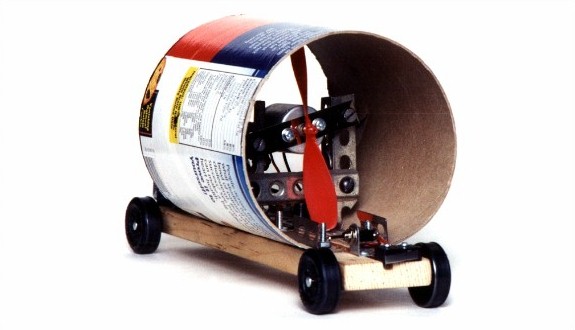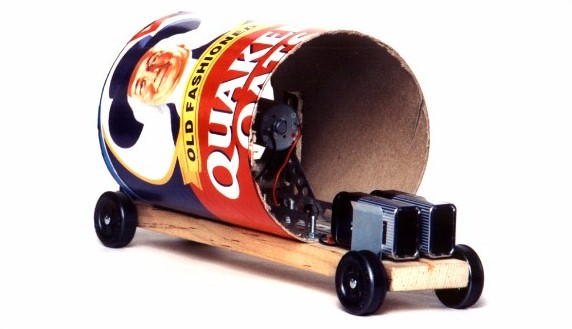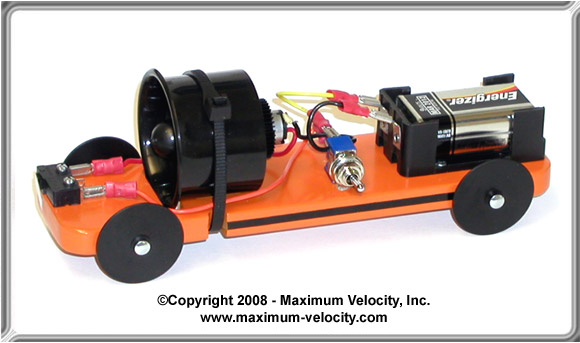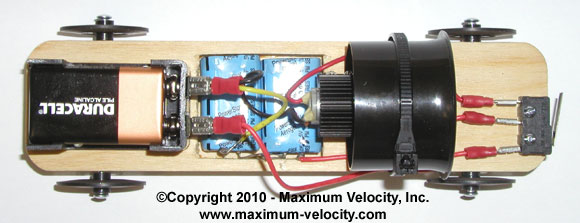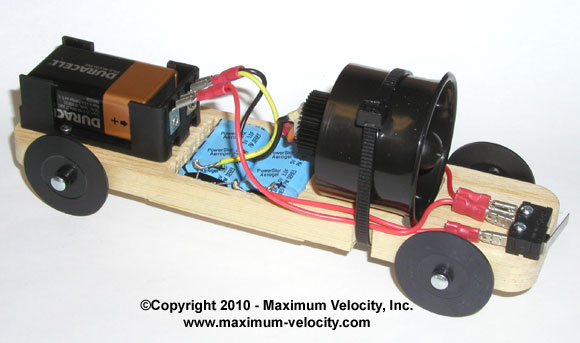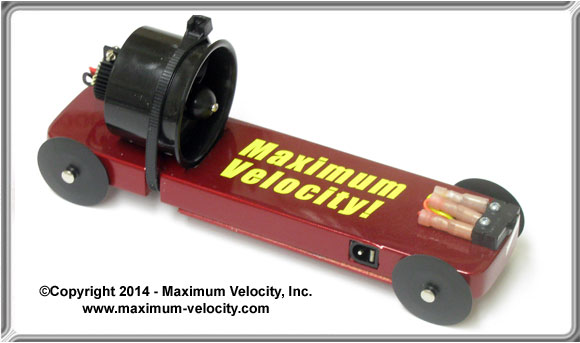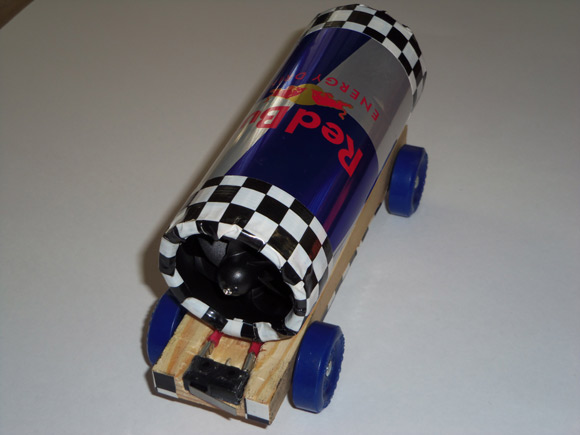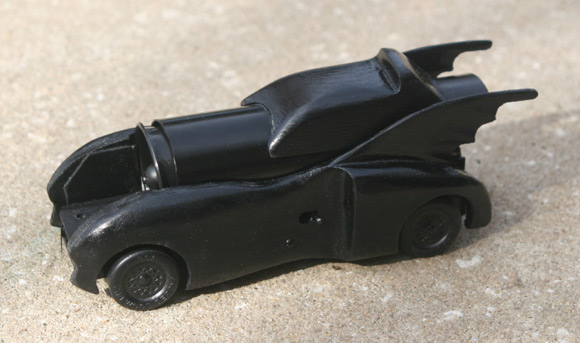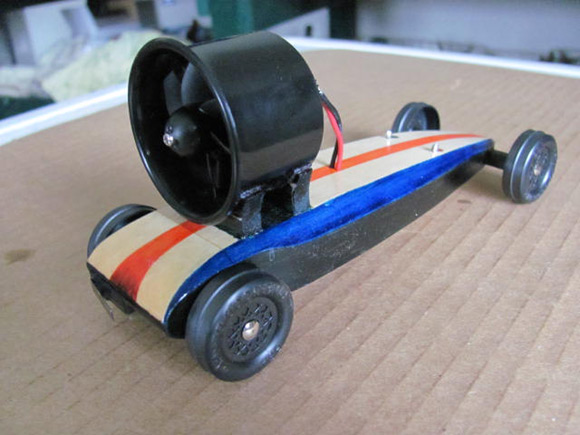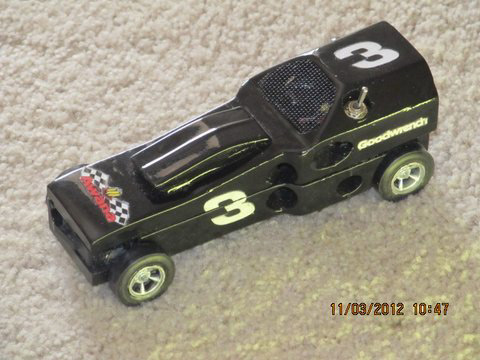– Feature Article – Propeller Car Evolution
– Pinewood Derby Car Showcase
– Q&A
Propeller Car Evolution
By Randy Davis
(The third in a series of articles originally published November 26, 2003 and December 1, 2010)
Many organizations sponsor open competition races, some of which allow the use of powered cars. Whether your organization holds this type of race, or you are looking for a “crowd pleaser”, the propeller car is a fairly simple way to get awesome speed from a pinewood derby car.
Propeller cars have come a long way since the first “Erector Set” version I built in 2001.
Figures 1 and 2 – Original Propeller Car
The Erector Set car is indestructible, but it carried too much weight to be fast.Through various iterations, the propeller car was optimized with the version we sold from 2008 to 2012.
Figure 3 – Production Propeller Car
This car had fewer parts, was light-weight, and used a compact ducted fan to produce crowd-pleasing speed.
Capacitor Car
But in the spirit of continuous improvement, more speed had to be found. This was accomplished in a novel way by Rod Shampine, and documented in Volume 10, Issue 5. Instead of feeding the motor directly with a 9 volt battery, Rod used capacitors to feed power to the motor. This allowed the motor to run at a higher RPM (the battery limited the amps available to the motor), thus producing more speed.
My first version of the capacitor car is shown in Figures 4 and 5.
Figures 4 and 5 – Original Capacitor Car
The car is similar to Rod’s design (but a bit more robust).1 When the front switch is not in contact with the track’s starting pin, the capacitors discharge to the fan and the battery is disconnected. After the capacitors are fully discharged, the car is fully inactive. When the car is placed on the track and the switch is depressed, the capacitors are disconnected from the fan, and the battery is connected to the capacitors. As long as the car sits at the starting gate for long enough, the capacitors will be fully charged for the run.
Propeller Car II
After some consideration, a few improvements to the capacitor car become obvious. First, removing the battery from the car reduces weight and increases the speed.2 Next, the wiring and capacitors could be mounted under the car for a cleaner look. Finally, the ducted fan was mounted at the back (more for looks than speed). This upgraded capacitor car design was available as a kit from Maximum Velocity for several years (see Figure 6).3
Figure 6 – Propeller Car II
The Propeller Car II is much faster than the previous version, is lighter weight, and has a sleeker design. The car is charged with a 9 volt battery using a power jack and plug (provided with the kit). The kit requires just a few common tools to assemble – no soldering is required.
Propeller Car II Performance
On a 32 foot track, the standard propeller car crosses the finish line in about 1.9 seconds. The Propeller Car II crosses the same distance in about 1.6 seconds. Not only is the capacitor version faster, but an added benefit is that it turns itself off, since the fan quits turning after the capacitors fully discharge. The links below have videos of the Propeller Car II racing against the original Propeller Car and a standard pinewood derby car. I think you will be able to figure out which is which!
Video 1 Propeller Car vs. Propeller Car II
(propcar2vs1.avi, 3.4MB)
Video 2 – Propeller Car vs. Standard Car
(propcar2.avi, 4.4MB)
So, if you want to blow away the competition in a real race, or just have a fun car to demonstrate at your event, consider building a propeller car.
1For more information on the design of a capacitor propeller car, Click Here.
2On a gravity powered car, more weight generally provides more speed. But on a powered car, lighter weight is better as this allows faster acceleration.
3Unfortunately, the ducted fan used on the Propeller Car II is no longer available so we can no longer offer the kit.
Pinewood Derby Car Showcase
Today we have a selection of ducted fan cars.
Red Bull – Travis Burkhardt
I added substantially more efficiency with the addition of a thrust tube. A Red Bull can is a perfect fit for the 40mm fan unit, 9V battery, front nose switch included. Total car weight of 5.0 ounces and all dimensions, axles, and wheels stayed within BSA standard rules. First Place finish and track record at 2.2 seconds.
Batmobile – Brian Amato
I decided to go for both form and function with my version of the propeller car kit. Of course I won the parent’s outlaw race!!!
Blown Away – Dennis Bjorn
I wanted to build a ducted fan car that didn’t show all the components. So I built “Blown Away”. The capacitors are inside the body. The car weighs 3.6 ounces. Running on a 35 foot Best Track my best time was 1.56 sec at 315 mph (scale speed).
Outlaw – Mike Henkelman
The “Outlaw” car was built for demonstration heats in the upcoming pinewood derby season. It features a ducted fan jet engine with a functional hood scoop, eight side air scoops, a mesh windshield (air scoop), and lithium polymer 11.1 volt batteries.
Q&A
I have a pinewood derby car that my oldest son used about 6 years ago to win his rank, pack, and district. The car was extremely fast and I would like to use the wheels and axles on my youngest son’s car this year. The car has just been sitting, and has not been played with like some of our cars. Do you think this would work, and if so would I need to do anything above and beyond the usual prep?
Congratulations on the fast car.
Does the car use BSA wheels and axles? If so, then I suggest going with new wheels. In 2009, the wheel molds were changed. The new wheels are lighter in weight and more accurate, so they tend to be quite a bit faster than the older wheels. You will also want to polish the axles again as they are likely tarnished.
We are wanting to do a Big Rig Truck race. We are looking for some rules of some sort. Can you help.
I suggest doing a Google search for Big Rig rules. Since the kits are no longer being offer by BSA, a rule set may be a bit difficult to find.
By the way, here is an article I wrote about the BSA Big Rig kit.
Want Answers?
Do you have a pinewood derby-related question? If so, e-mail us your question.We answer all questions by e-mail, but not every question will appear in the Q&A section of the newsletter.
Back Issues
Are you a new subscriber, or have you missed some of the previous newsletters? Don’t miss out; all of the issues for Volume 5 through Volume 17 are posted on our web site.
Newsletter Contributions
We welcome your contributions. If you would like to contribute an article, a web site review, a speed tip, or a pinewood derby memory, please e-mail us.
Subscription Information
The Pinewood Derby Times is a free e-newsletter focused on pinewood derby racing. It is published biweekly from October through March.
If you haven’t already done so, please forward this issue to your pinewood derby friends. But please don’t subscribe your friends. Let them decide for themselves. Thanks.
If this newsletter was forwarded to you, why not subscribe to receive this newsletter. There is no cost, and your e-mail address is safe, as we never sell or share our distribution list.
To subscribe, send a blank e-mail to
[email protected]
You will receive a confirmation e-mail. Reply to the confirmation e-mail and you will start receiving the Pinewood Derby Times with the next issue.
Randy Davis, Editor, Pinewood Derby Times
E-Mail: [email protected]
(C)2018, Maximum Velocity, Inc. All rights reserved. Please do not reprint or place this newsletter on your web site without explicit permission. However, if you like this newsletter we grant permission, and encourage you to e-mail it to a friend.
Maximum Velocity disclaims any personal loss or liability caused by utilization of any information presented in this newsletter.
The Pinewood Derby Times is not specific to, and is not affiliated with the Boy Scouts of America, YMCA, Awana, or any other organization.
(R)Maximum Velocity is a registered trademark of Maximum Velocity, Inc.
(R)Pinewood Derby is a registered trademarks of the Boys Scouts of America.
(R)Awana is a registered trademark of Awana Clubs International.
All other names are trademarks of their respective owners.

